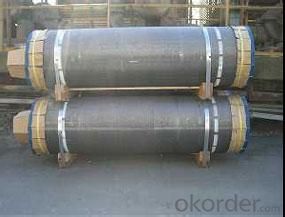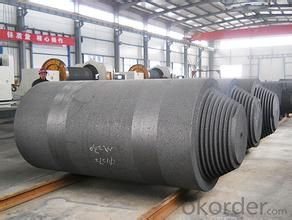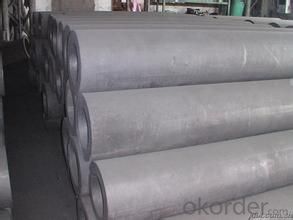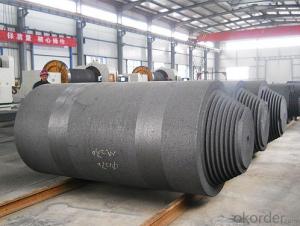Carbon Electrode With Φ500~Φ700 G Grade And Stable Quality
- Loading Port:
- Tianjin
- Payment Terms:
- TT or LC
- Min Order Qty:
- 20 m.t.
- Supply Capability:
- 800 m.t./month
OKorder Service Pledge
Quality Product, Order Online Tracking, Timely Delivery
OKorder Financial Service
Credit Rating, Credit Services, Credit Purchasing
You Might Also Like
General Specification
PARAMETER UNIT GUARANTEE VALUE | ||||||
Ash.( % ) | 4.0 max | 5.0 max | 6.0 max | 7.0 max | 9.0 max | 11.0 max |
V.M (%) | 12.0-15.5 | 12.0-15.5 | 12.0-15.5 | 9.5-13.5 | 11.5-15.5 | 11.5-15.5 |
Compress Strength. (Mpa) | 18.0 min | 17 min | 15.7 min | 19.6 min | 19.6 min | 19.6 min |
Specific Resistance (μΩm) | 65 max | 68 max | 75 max | 80 max | 90 max | 90 max |
Bulk Density (G/CM3) | 1.38 min | 1.38 min | 1.38 min | 1.38 min | 1.38 min | 1.38 min |
Product Description
Carbon Electrode is abaked electrode used in submerged arc furnaces for delivering power to the charge mix. Electrode is added to the top of the electrode column cylindrical form. Electrode is essentially a mix of Electrically Calcined Anthracite (ECA) or Calcined Petroleum Coke (CPC) with Coal Tar Pitch and is baked for weeks, it is widly used for for ferroalloy,calcium carbide, silicon metal, production etc.
Picture



We Also supply all kind of carbon electrode paste and below materials, please contact us if you have any enquiry about it.
Calcined Anthracite
Calcined Petroleum Coke
Coke (Met Coke, Foundry Coke, Semi Coke)
- Q:What are the effects of carbon emissions on the stability of desertification?
- Desertification is significantly impacted by carbon emissions, which arise from human activities such as burning fossil fuels and deforestation, releasing carbon dioxide and other greenhouse gases into the atmosphere. These emissions contribute to the global warming phenomenon, which in turn leads to various adverse effects on desertification. One major consequence of carbon emissions is the alteration of precipitation patterns. As the planet warms, the evaporation rate rises, causing more moisture to be held in the atmosphere. Consequently, there is reduced rainfall in numerous regions, particularly in arid and semi-arid areas that are already prone to desertification. The scarcity of water exacerbates the dry conditions, thereby facilitating and intensifying desertification. Additionally, the higher temperatures resulting from carbon emissions contribute to the acceleration of soil erosion. As the land heats up, it becomes more susceptible to erosion caused by wind and water. This erosion leads to the loss of topsoil, which is vital for plant growth and stability. Without a stable layer of topsoil, vegetation struggles to establish and survive, ultimately causing the expansion of deserts. Furthermore, carbon emissions also impact plant communities' health and productivity. While increased levels of carbon dioxide can stimulate plant growth in certain cases, it often results in the proliferation of invasive species that are better adapted to the changing conditions. These invasive species outcompete native plants, diminishing biodiversity and further destabilizing the ecosystem. Additionally, as desertification progresses, the loss of plant cover reduces the capacity to sequester carbon, leading to even higher carbon dioxide levels in the atmosphere. In conclusion, carbon emissions have detrimental effects on desertification's stability. They disrupt precipitation patterns, accelerate soil erosion, reduce plant productivity, and diminish the capacity to sequester carbon. To mitigate these impacts and prevent further progression of desertification, it is crucial to reduce carbon emissions through sustainable practices and conservation efforts.
- Q:How does carbon affect the taste of food and beverages?
- Carbon, in the form of activated charcoal or carbonation, can significantly affect the taste of food and beverages. Activated charcoal is known for its ability to absorb impurities and toxins, making it a popular ingredient in various food and drink products. When added to food and beverages, activated charcoal can help remove unpleasant odors and flavors, resulting in a cleaner and more enjoyable taste. In terms of carbonation, it is widely used in beverages to create fizziness and enhance the overall sensory experience. Carbon dioxide gas is dissolved in liquids under pressure, which creates bubbles when the pressure is released, giving the drink a refreshing and effervescent quality. This carbonation effect can add a tangy or slightly acidic taste to the beverage, which is often considered pleasant and invigorating. Moreover, carbonation can also influence the taste of food. For example, the carbonation present in beer or sparkling wine can help cut through the richness of certain dishes, balancing flavors and providing a more refreshing palate cleanse. Carbonation can also be added to certain foods, such as bread or pastry dough, helping them rise and creating a lighter texture. It is important to note that while carbon can enhance the taste of food and beverages, its impact can vary depending on the specific application and concentration used. Additionally, the taste of carbon in food and beverages is subjective, and some people may prefer non-carbonated or charcoal-free options. Ultimately, the use of carbon in culinary applications offers a wide range of possibilities for taste enhancement and sensory experiences.
- Q:What are the properties of carbon-based textiles?
- Carbon-based textiles have a number of unique properties that make them advantageous in various applications. Firstly, carbon-based textiles exhibit exceptional strength and durability. They are known for their high tensile strength, making them resistant to stretching and tearing. This property allows carbon textiles to withstand harsh conditions and maintain their integrity over time. Secondly, carbon-based textiles possess excellent thermal conductivity. They can efficiently conduct heat, making them suitable for applications that require effective heat management. This property is particularly useful in industries such as aerospace, automotive, and electronics, where heat dissipation is essential to prevent system failures. Furthermore, carbon textiles are highly resistant to chemical corrosion. They can withstand exposure to various chemicals, acids, and solvents without losing their structural integrity. This property makes carbon-based textiles ideal for applications in the chemical industry, where exposure to corrosive substances is common. Another notable property of carbon textiles is their inherent flame resistance. They have a high resistance to ignition and do not propagate flames easily. This characteristic makes them suitable for use in environments where fire safety is crucial, such as in protective clothing for firefighters and military personnel. Carbon-based textiles also exhibit good electrical conductivity, making them suitable for applications in electronics and electrical engineering. They can effectively conduct electricity and dissipate static charges, reducing the risk of electrical malfunctions or damage. Lastly, carbon textiles have a low coefficient of thermal expansion, meaning they do not expand or contract significantly with changes in temperature. This property makes them dimensionally stable, ensuring that they maintain their shape and size under varying thermal conditions. In summary, carbon-based textiles possess a combination of strength, durability, thermal conductivity, chemical resistance, flame resistance, electrical conductivity, and dimensional stability. These properties make them highly versatile and suitable for a wide range of applications in various industries.
- Q:I heard that 85 of the furnace rock carbon harmony, and the result that I use advanced strengthening machine when I want to give high-grade furnace rock carbon, this how ah?
- This can be purchased in previous events, but not at the moment, but after all, there has been a high-level reinforcement machine, which is expected to come out later
- Q:What are the properties of carbon-based ceramics?
- Carbon ceramics, also called carbon-based ceramics, are a distinct group of materials known for their exceptional properties, making them highly sought-after for various uses. These properties consist of: 1. Exceptional resistance to high temperatures: Carbon ceramics demonstrate remarkable thermal stability, enabling them to endure extremely high temperatures without significant deterioration or structural changes. This characteristic renders them ideal for applications in high-temperature environments like aerospace components, brake systems, and heat shields. 2. Low density: Carbon ceramics are characterized by their lightweight nature due to their low density. This quality proves advantageous in industries where weight reduction is essential, such as automotive and aerospace, as it enhances fuel efficiency and overall performance. 3. High hardness and resistance to wear: Carbon-based ceramics possess outstanding hardness and wear resistance, endowing them with durability and the ability to withstand abrasive forces. This attribute makes them suitable for use in cutting tools, bearings, and other applications that require resistance to wear and erosion. 4. Excellent resistance to chemicals: Carbon ceramics are renowned for their excellent chemical resistance, enabling them to withstand corrosion and degradation when exposed to aggressive chemical environments. This property proves valuable in industries like chemical processing, semiconductor manufacturing, and others that require resistance to chemical attack. 5. Good electrical conductivity: Unlike traditional ceramics, carbon-based ceramics exhibit good electrical conductivity due to the presence of carbon in their composition. This quality makes them useful in applications that necessitate both thermal insulation and electrical conductivity, such as heating elements, electrodes, and electronic components. 6. Customizable properties: Carbon ceramics offer the advantage of tailoring their properties to meet specific requirements by adjusting the composition and processing methods. Variables like carbon content, porosity, and microstructure can be modified to customize the mechanical, thermal, and electrical properties of carbon ceramics to suit particular application needs. In conclusion, carbon-based ceramics possess a unique set of properties, including high temperature resistance, low density, high hardness, excellent chemical resistance, good electrical conductivity, and the ability to customize their properties. These properties make them valuable materials across a wide range of industries, including aerospace, automotive, chemical processing, and electronics.
- Q:RT~ I remember our teacher said, but I forgot all of a sudden......Ask for advice!
- Well, secondary carbon and oxygen double bonds do not add much. What is involved in high school?:1, in the nickel catalyzed conditions, with H2 addition (also a reduction, but note that in the carboxyl group -COOH carbon oxygen double bond can not be added by the general method plus H)2, aldehyde addition (aldol condensation). The college entrance examination had many times, is simply an aldehyde -CHO under certain conditions and containing active H group reaction R-H (commonly known as alpha H that -H doesn't have to be in the next -CHO H, like -COOH, phenyl can also, but to see more in the next -CHO generation of C- (OH) -R). The H is added to the O, and the alkyl R- is added to the C.For example: CH3-CHO+HCHO==CH3-C (OH) -CHO (called 2- 3-hydroxypropanal)There are some universities, the mechanism involved is more complex, you want to HI me
- Q:What are the challenges and opportunities of transitioning to a low-carbon economy?
- The challenges of transitioning to a low-carbon economy include the need for significant investments in renewable energy infrastructure, the potential loss of jobs in fossil fuel industries, and the complexity of implementing new policies and regulations. Additionally, there may be resistance from certain industries or regions that heavily rely on carbon-intensive practices. However, this transition also presents numerous opportunities. It allows for the development of sustainable and innovative industries, such as renewable energy technologies, electric vehicles, and energy-efficient buildings. It can create new job opportunities in these emerging sectors and stimulate economic growth. Moreover, transitioning to a low-carbon economy helps mitigate climate change, reduce air pollution, and improve public health, leading to a more sustainable and resilient future.
- Q:Where are carbon fiber sheets and carbon fiber sheets used?
- Carbon reinforced materials, carbon fiber cloth is mainly used for concrete beam flexural and shear strengthening, flexural reinforcement, column reinforcement plate; plant, buildings, schools, hospitals and other industrial and civil building reinforcement; Luqiao, water conservancy, nuclear power and energy infrastructure reinforcement.Carbon fiber board is mainly used for concrete structure plate and beam repairing and reinforcing plate; opening wall and surrounding reinforcement; the wooden building beam reinforcement; reinforced bridge, bridge pier, truss; tunnel, cable pipeline repairing and reinforcing.
- Q:What are the 3K, 12K, UD, etc. in the appearance requirements of the carbon fiber bicycle? What's the difference?
- 3K and "12K" refer to carbon fiber woven fabrics. 3K 12K cloth cloth texture is fine, coarse texture.UD is not imitation carbon fiber, refers to the polyethylene fiber woven fabric, the strength is lower than the carbon fiber, but the density is smaller than the carbon fiber, is often used to make bullet proof material.Carbon fiber and polyethylene fiber belong to high performance fiber.Advisory 181150695.
- Q:What is carbon black rubber?
- Carbon black rubber is a type of rubber that contains carbon black as an additive. Carbon black is a finely divided form of carbon, produced by the incomplete combustion of hydrocarbon fuels. It is added to rubber compounds to improve its mechanical properties, such as tensile strength, abrasion resistance, and resilience. The carbon black particles are dispersed within the rubber matrix, providing reinforcement and enhancing its durability and performance. Carbon black rubber is commonly used in the production of tires, conveyor belts, gaskets, seals, and various automotive and industrial rubber products.
1. Manufacturer Overview |
|
|---|---|
| Location | |
| Year Established | |
| Annual Output Value | |
| Main Markets | |
| Company Certifications | |
2. Manufacturer Certificates |
|
|---|---|
| a) Certification Name | |
| Range | |
| Reference | |
| Validity Period | |
3. Manufacturer Capability |
|
|---|---|
| a)Trade Capacity | |
| Nearest Port | |
| Export Percentage | |
| No.of Employees in Trade Department | |
| Language Spoken: | |
| b)Factory Information | |
| Factory Size: | |
| No. of Production Lines | |
| Contract Manufacturing | |
| Product Price Range | |
Send your message to us
Carbon Electrode With Φ500~Φ700 G Grade And Stable Quality
- Loading Port:
- Tianjin
- Payment Terms:
- TT or LC
- Min Order Qty:
- 20 m.t.
- Supply Capability:
- 800 m.t./month
OKorder Service Pledge
Quality Product, Order Online Tracking, Timely Delivery
OKorder Financial Service
Credit Rating, Credit Services, Credit Purchasing
Similar products
New products
Hot products




























